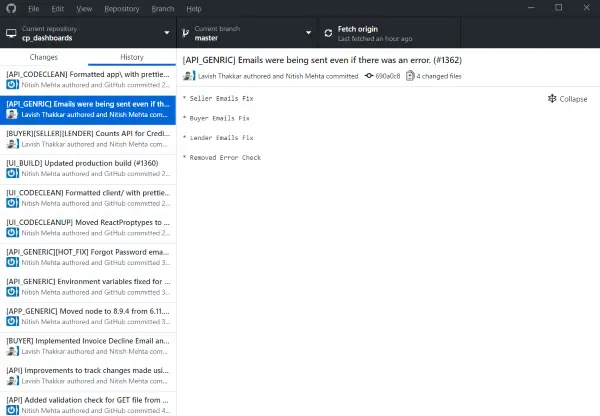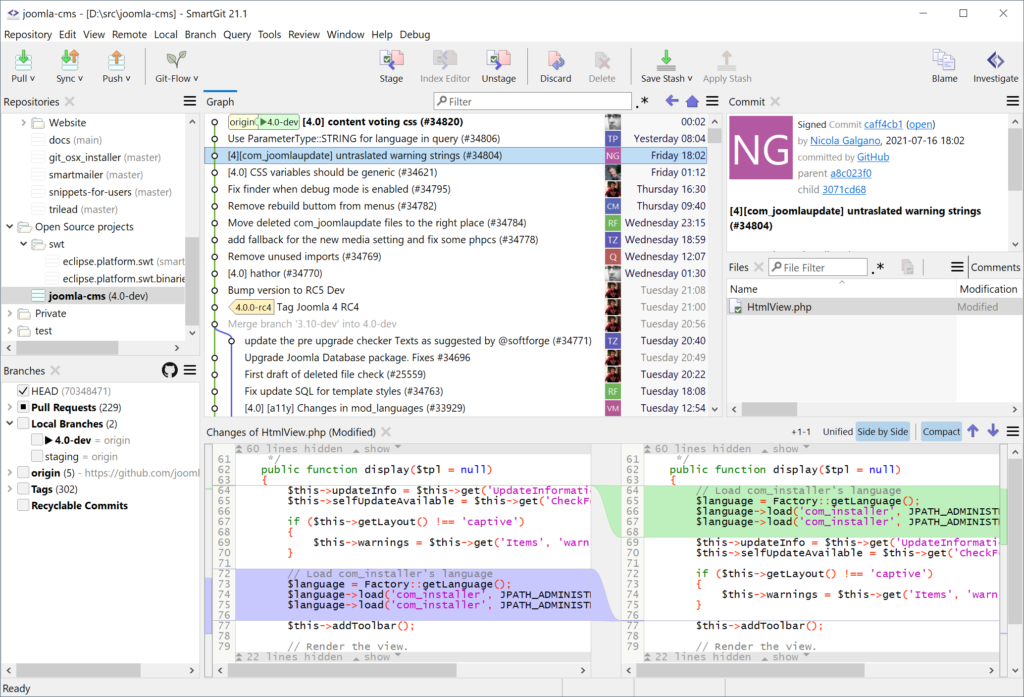


- #Review of git gui client for mac how to
- #Review of git gui client for mac software
- #Review of git gui client for mac password
- #Review of git gui client for mac mac
After you install Git on Mac, you might find helpful How to Update Git. Now, the output tells you the working tree is clean, and there is nothing to commit.Īs you can see, it is not difficult to install Git on Mac. Commit all changes and add a message that describes the commit: git commit -m "added test1.txt" However, you still need to commit this change.Ĩ. If you recheck the git status now, you would see that the file is now being tracked (as it changed from red to green). Prompt Git to track the new file by running: git add test1.txt Git is tracking the folder in which the file was added, and notifies you that the changes are not being tracked.ħ. The output tells you there are untracked files inside the directory and lists file1.txt. Add some files inside NewFolder and see how the git status changes: touch file1.txt Since the folder we created doesn’t have any files in it, the output responds with: nothing to commit.ĥ. This shows the state of the working directory and displays if any changes made inside the directory. While in the directory NewFolder, type the following command: git status If you want to hide the folder again, modify the last part of the command by changing the YES to NO).Ĥ. git folder, you need to run the command: defaults write AppleShowAllFiles YES. With this, you have added a hidden folder inside the directory by the name. Running the git init command initializes an empty git repository in this particular location. As we want to keep track of changes inside this folder, we need to create a local Git repository for it. cd /Users//Desktop/Tools/Git/NewFolder/ģ. The path may differ according to the location where you created the new folder. mkdir /Users//Desktop/Tools/Git/NewFolderĢ.

First, open the terminal and create a new folder named NewFolder. To demonstrate how to work with files on local Git repositories, we are going to create a demo folder and file to work with.ġ. Then, add your email: git config -global user.email " " Track and Commit Changes Open the terminal and configure your GitHub username: git config -global user.name "your_github_username" This is important as it helps keep track of which user is committing changes to a project. The next step is to configure Git by adding your credentials to the system.
#Review of git gui client for mac mac
Add the bash-completion, svn, and the docs to the command for installing: sudo port install git +svn +doc +bash_completion +gitweb Get Started with Git on Mac Configure Git Note: When setting up Git with MacPorts, you can install additional tools you may find useful in the future. Then, install Git with: sudo port install git Search for and install the newest Git ports and variants by running the following two commands: port search git port variants git Start by updating MacPorts with the command: sudo port selfupdate If you are using MacPorts to manage your packages on the system, you can use the port command to set up Git. Then, check the Git version to verify the installation: git -version Install Git Using MacPorts Run the following brew command in the terminal: brew install git Install Git Using HomebrewĪnother way to install Git is with Homebrew, the package management system for Mac. Confirm the installation, and Xcode sets up Git. If you do not have Git, it automatically asks you whether you want to install it. The output should display the latest Git release, as in the example below. With Xcode running on your Mac, you can check whether Git is also available by prompting for the Git version: git -version Users who don’t have Xcode can install it with a single command: xcode-select -install Its command-line tools include Git in the package. If you prefer the terminal, using Xcode is the fastest and easiest way to start working with Git. This guide includes three different options. There are multiple ways to install Git on Mac via terminal, depending on the development environment or package manager you have on your system. Option 2: Install Git on Mac using the Terminal Move on to the next step of configuring Git. With this, you have finished setting up Git on your Mac. Confirm once again by clicking Install Software.
#Review of git gui client for mac password
Click Install and type in your password if necessary.ħ. If you are new to version control systems, the best option would be to leave the default settings.Ħ. Follow the installation wizard and configure Git to suit your development needs.

Find the package and double-click to open the Git installer.ĥ.
#Review of git gui client for mac software
Click Download, and it automatically downloads the software package on your system.Ĥ.


 0 kommentar(er)
0 kommentar(er)
